Embarking on a low-carb or ketogenic diet doesn’t necessarily mean giving up bread entirely. While traditional bread, with its high carbohydrate content, isn’t compatible with the strict macronutrient ratios required for ketosis, several inventive substitutes provide the same comfort and versatility without derailing one’s dietary objectives.
From grain-free options like cloud bread to recipes using nut flours such as almond or coconut, these alternatives allow those following a keto diet to enjoy sandwiches, toast, and other bread-based dishes.
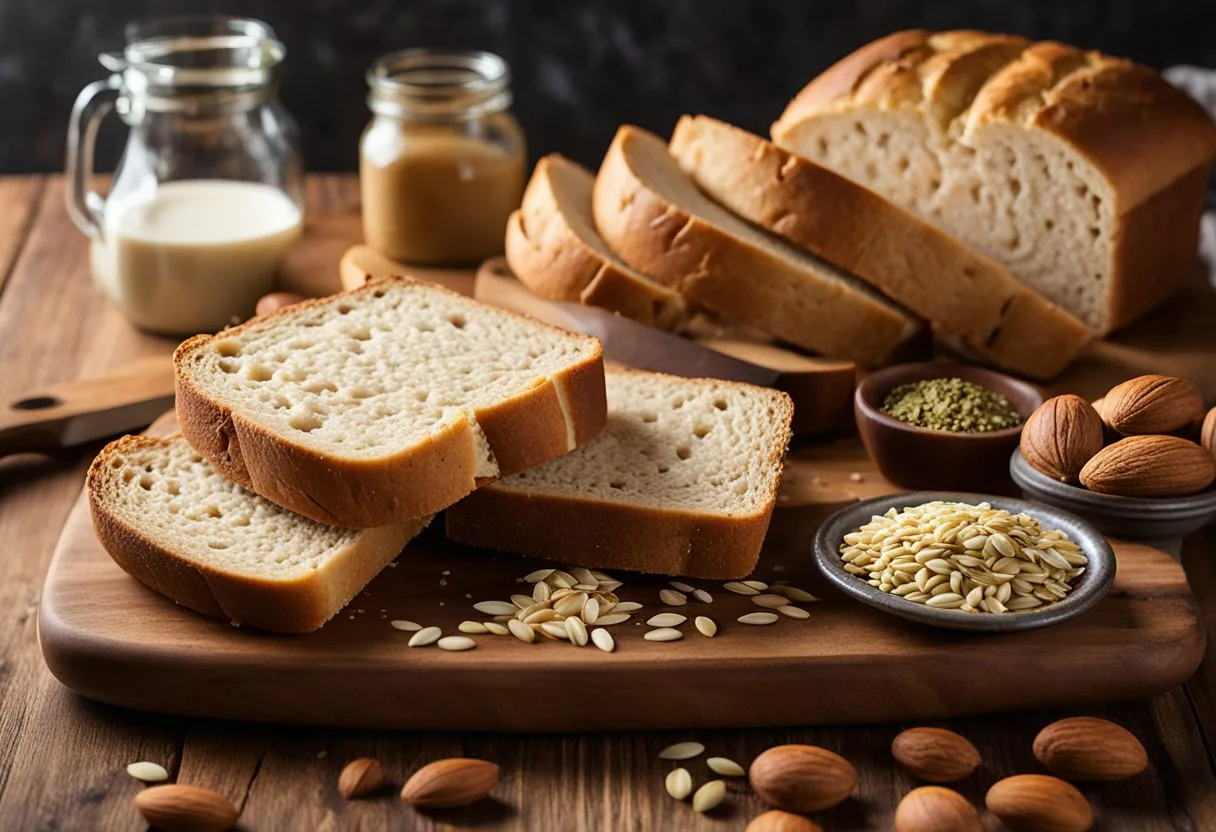
The market for keto bread alternatives has expanded, with a variety of store-bought and homemade options available. Some popular substitutes include bread made from proteins or cheese, known as oopsie or cloud bread, as well as various seed or nut-based bread such as those made with almond or coconut flour, offering minimal net carbs per slice.
For those cooking at home, creating keto-friendly bread allows for customization of ingredients and flavors to cater to individual preferences and health goals.
Key Takeaways
- Keto-friendly bread alternatives allow individuals to enjoy bread-like foods without significantly increasing carb intake.
- A broad spectrum of keto bread options is available, including both homemade recipes and store-bought products.
- These alternatives often utilize ingredients such as nut flours, seeds, and proteins to maintain compliance with keto dietary standards.
Understanding the Keto Diet
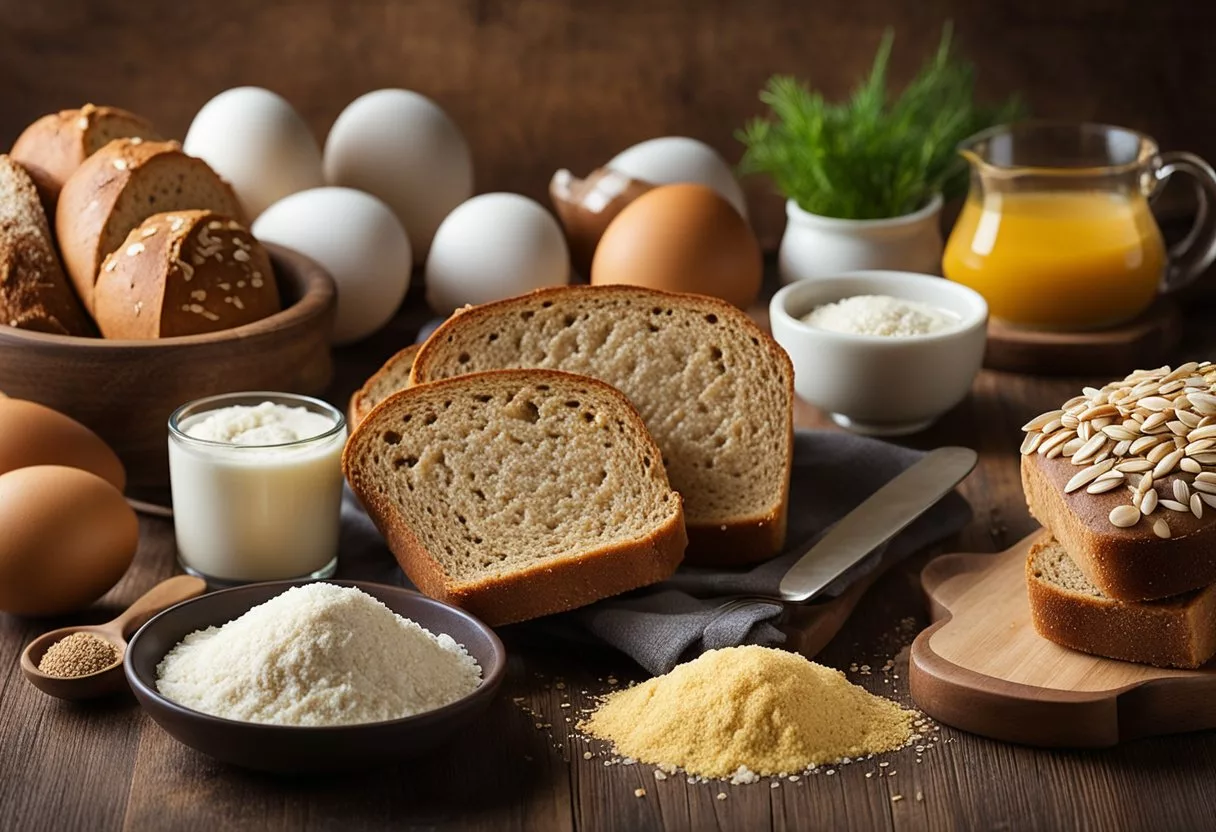
The keto diet revolves around inducing a state of ketosis in the body for weight management and potential health benefits. It focuses on high-fat, moderate protein intake, and drastically reduced carbohydrates.
Principles of Ketosis
Ketosis is a metabolic state in which the body uses fat as its primary fuel source instead of carbohydrates. This shift occurs when carbohydrate intake is limited to typically fewer than 50 grams per day, prompting the liver to convert fat into fatty acids and ketone bodies. These ketones then serve as a fuel source for the body and brain. The goal of the keto diet is to maintain a state of ketosis where the body is efficient at burning fat.
- Net Carbs: Total carbohydrates minus fiber, important to track for maintaining ketosis.
- Protein: Sufficient intake is crucial to preserve muscle mass, but excess can hinder ketosis.
- Fiber: Although a carb, it does not raise blood sugar levels and aids in digestion.
- Fat: The cornerstone of the keto diet, providing the majority of daily calories.
Health Benefits and Considerations
While the primary aim of the ketogenic diet is often weight loss, there are other potential health benefits that individuals may experience. There is evidence that a keto diet can improve blood sugar levels in people with type 2 diabetes, as well as potentially reduce the risk of heart disease. Some people also report improved mental clarity and sustained energy levels throughout the day.
However, following a keto diet may come with considerations:
- Nutrient Deficiency: Due to the restriction of certain fruits, vegetables, and grains, there is a risk of missing out on essential nutrients.
- Cholesterol Levels: Individuals may see a rise in LDL cholesterol levels, which should be monitored.
- Keto Flu: A transition period that can include symptoms like fatigue and headaches as the body adjusts to ketosis.
- Long-Term Sustainability: The restrictive nature of the diet raises questions about the long-term feasibility and effects on social eating habits.
The Role of Bread in a Keto Diet
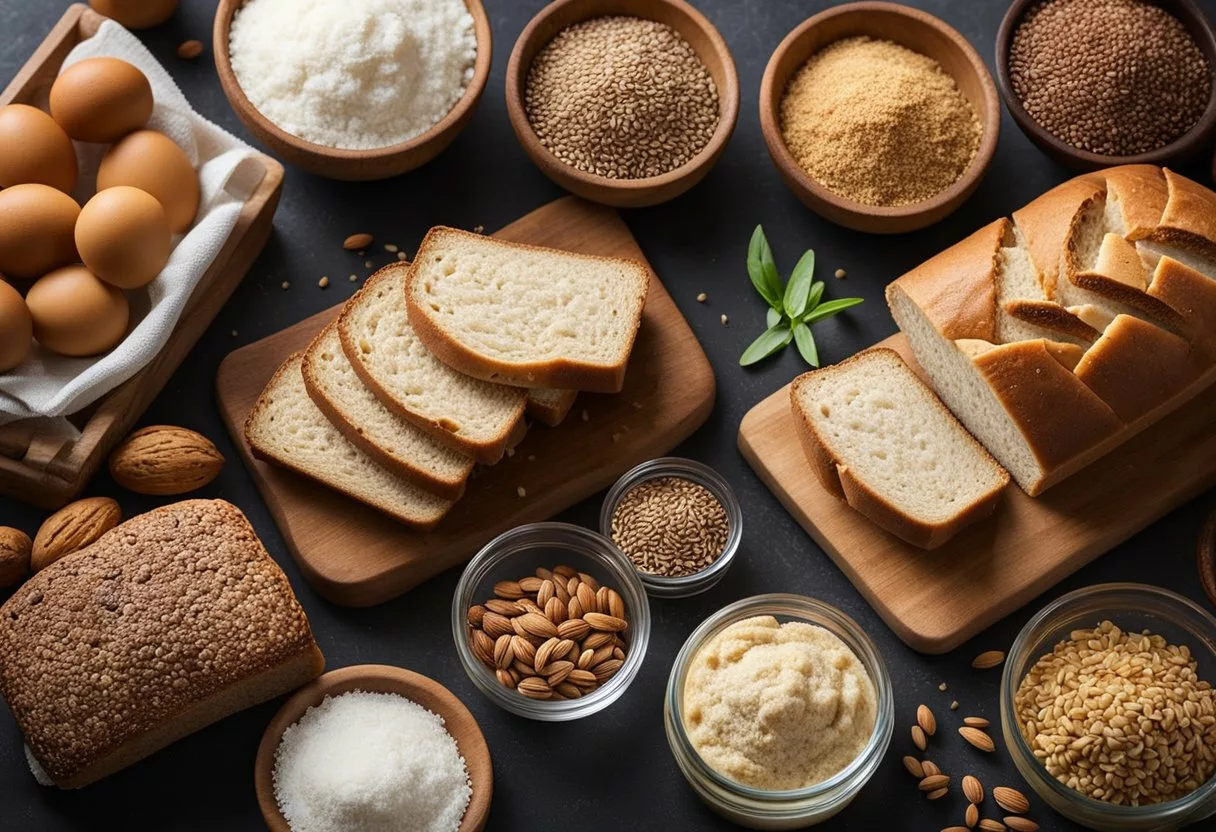
Bread’s traditional role as a common source of carbohydrates presents a significant challenge for individuals following a keto diet, and the adaptation of bread formulations to meet keto-friendly criteria is essential.
Challenges of Traditional Bread
Traditional bread, typically made from wheat and high in carbohydrates, conflicts with the ketogenic diet’s requirement to limit carb intake. Regular white and brown breads contain about 13-15 grams of carbs per slice, which can quickly exceed the keto diet’s strict carb restrictions. A staple in many diets, bread’s grain-based composition and the presence of sugars make it unfriendly for keto adherents who aim to reduce net carb consumption to maintain ketosis, a metabolic state in which the body burns fat for energy instead of carbohydrates.
Keto-Friendly Bread Characteristics
Keto bread alternatives are designed to offer the comfort of bread without the high net carb content. Key characteristics of keto-friendly bread include:
- Low net carbs: Essential for maintaining ketosis; ideally under 10 grams per serving.
- High in fiber: Compensates for the reduction in net carbs.
- Grain-free formulations: Commonly replaced with almond, coconut, or other nut flours.
- No added sugars: To minimize carbohydrate content.
Keto bread products may incorporate ingredients like cream cheese and eggs, providing a protein-rich profile that suits the dietary needs of keto enthusiasts. The use of low-carb flour substitutes such as those from nuts and the absence of traditional grains reflect the demand for keto-compliant bread alternatives that mimic the texture and taste of conventional bread while adhering to the strict dietary guidelines.
Primary Ingredients for Keto Bread Alternatives
Crafting keto-friendly bread alternatives typically involves using low-carbohydrate ingredients that mimic the properties of traditional bread. This section outlines specific components used in creating these substitutes, ensuring they align with keto dietary requirements.
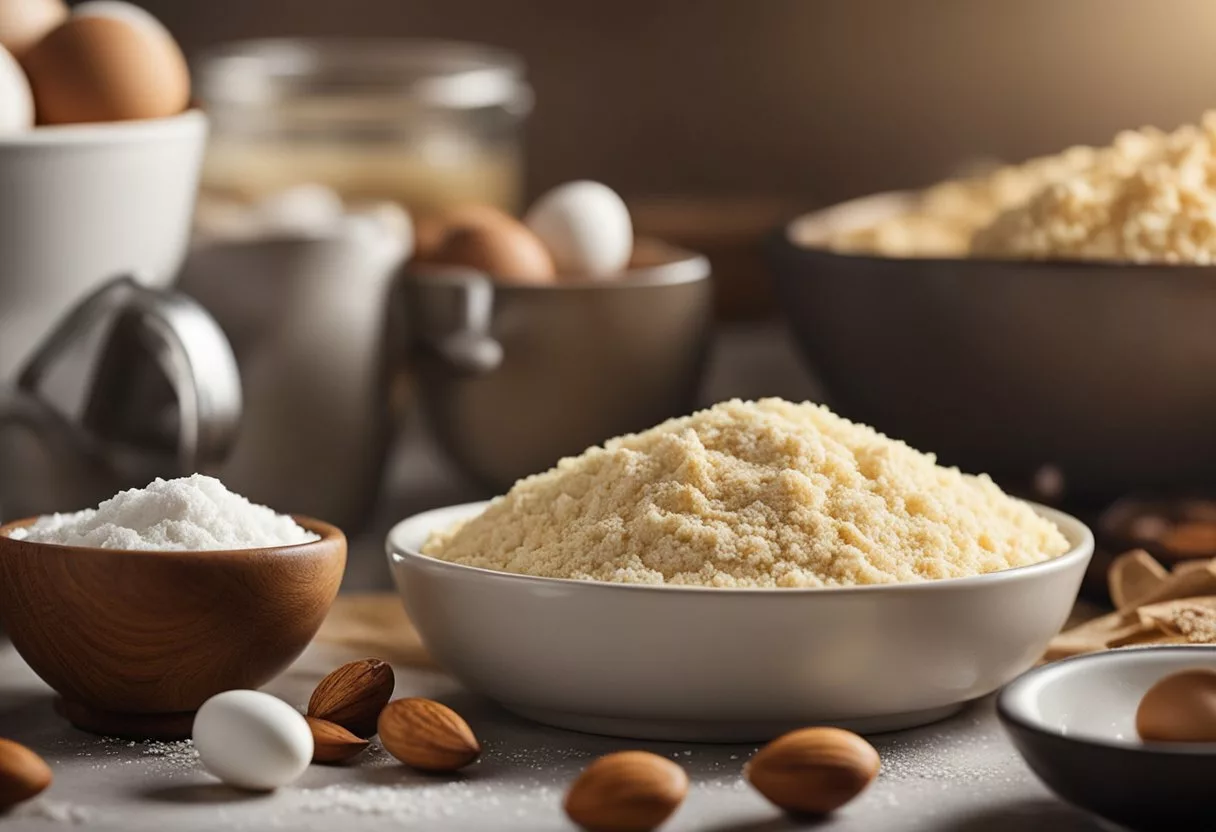
Flour Substitutes
For the foundation of most keto bread alternatives, traditional wheat flour is replaced with:
- Almond Flour: High in fiber and healthy fats, almond flour provides a bread-like texture while keeping carb counts low.
- Coconut Flour: A dense flour alternative, coconut flour is favorable for its low carbohydrate content and ability to absorb moisture, requiring adjustments in liquid ratios in recipes.
Binding Agents
To help these bread substitutes retain their structure and texture, binding agents are essential:
- Eggs: Eggs serve multiple purposes in keto baking, acting as a binding agent while also providing leavening properties and additional richness.
- Psyllium Husk Powder: This fiber-rich ingredient helps to bind ingredients and can mimic the texture of gluten, adding elasticity to the dough.
- Cream Cheese: Often used for its creamy texture and flavor, cream cheese can help in binding ingredients together in recipes like cloud bread.
Rising Ingredients
Bread’s airy and light characteristics are imparted by leavening agents that react to create bubbles of carbon dioxide:
- Baking Powder: A combination of a carbonate or bicarbonate and a weak acid, baking powder is used to increase the volume and lighten the texture of baked goods.
- Baking Soda: When mixed with acids like apple cider vinegar, baking soda helps the bread rise and provides a fluffier texture.
- Apple Cider Vinegar: When combined with baking soda, it acts as a leavening agent, contributing to the rise and improving the texture of keto breads.
Popular Keto Bread Alternatives
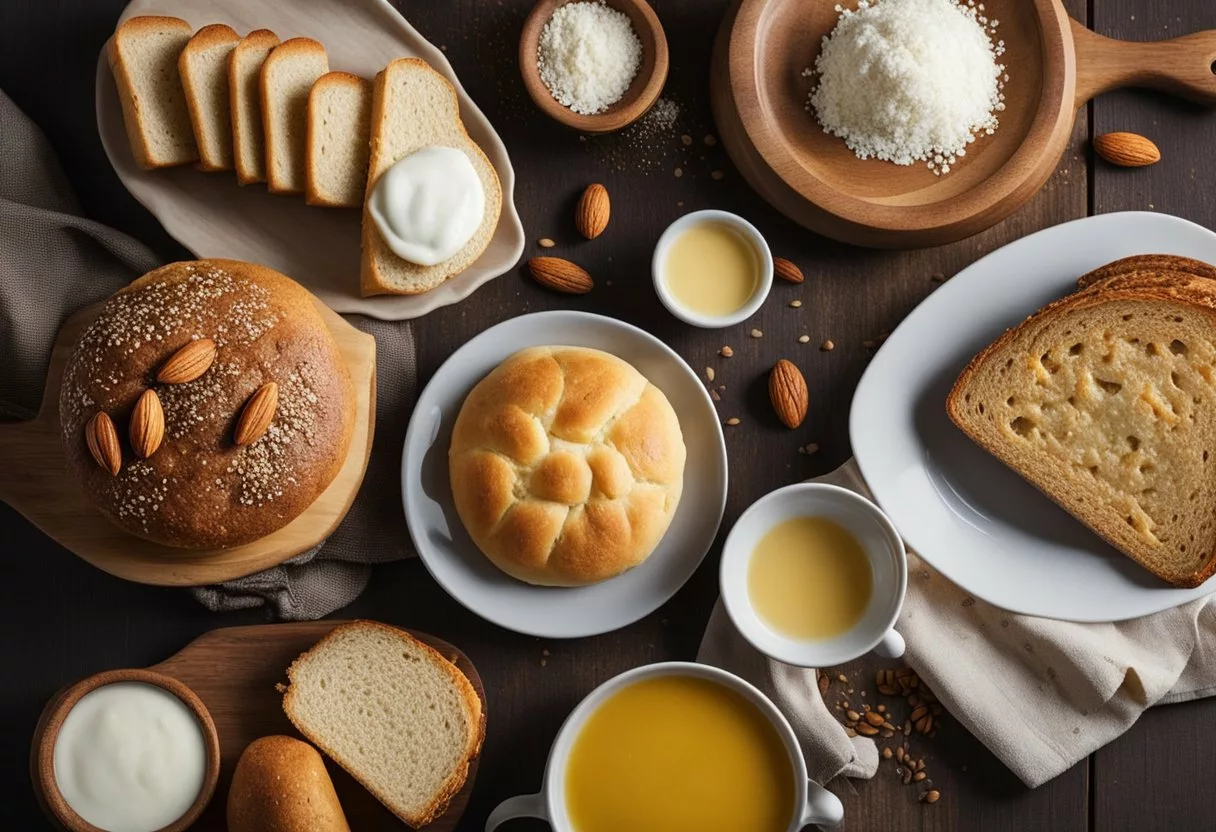
For those adhering to a ketogenic lifestyle, traditional bread can disrupt macronutrient targets. Fortunately, there are several bread alternatives that align with keto dietary needs.
Cloud Bread
Cloud bread, a light and airy option, consists primarily of eggs, cream cheese, and a leavening agent. It has a mild, somewhat eggy flavor and is soft in texture, making it suitable for a variety of toppings. With its small size, it’s a convenient choice for sliders or mini sandwiches.
Oopsie Bread
Oopsie bread is similar to cloud bread with a main composition of eggs and cream cheese, delivering a delicate, light texture. Often enjoyed for its subtle taste and flexible applications, one can use it just as they would traditional sandwich bread without the added carbs.
Almond Flour Bread
Almond flour bread brings a rich, nutty flavor and a bread-like texture that satisfies the palate. Heavier and denser than cloud-based alternatives, this type of bread holds up well to slicing and spreads. Almonds being its key ingredient attribute to a slightly grainy yet moist texture.
Coconut Flour Bread
Coconut flour bread is a denser bread alternative known for its slight coconut flavor and a texture that’s both soft and firm. Ideal for those who prefer a less eggy taste, it is a versatile keto-friendly option that pairs well with various sweet and savory toppings. Its size typically mirrors that of traditional bread, making it a seamless substitute for regular loaves.
Other Low-Carb Substitutes for Traditional Bread Uses
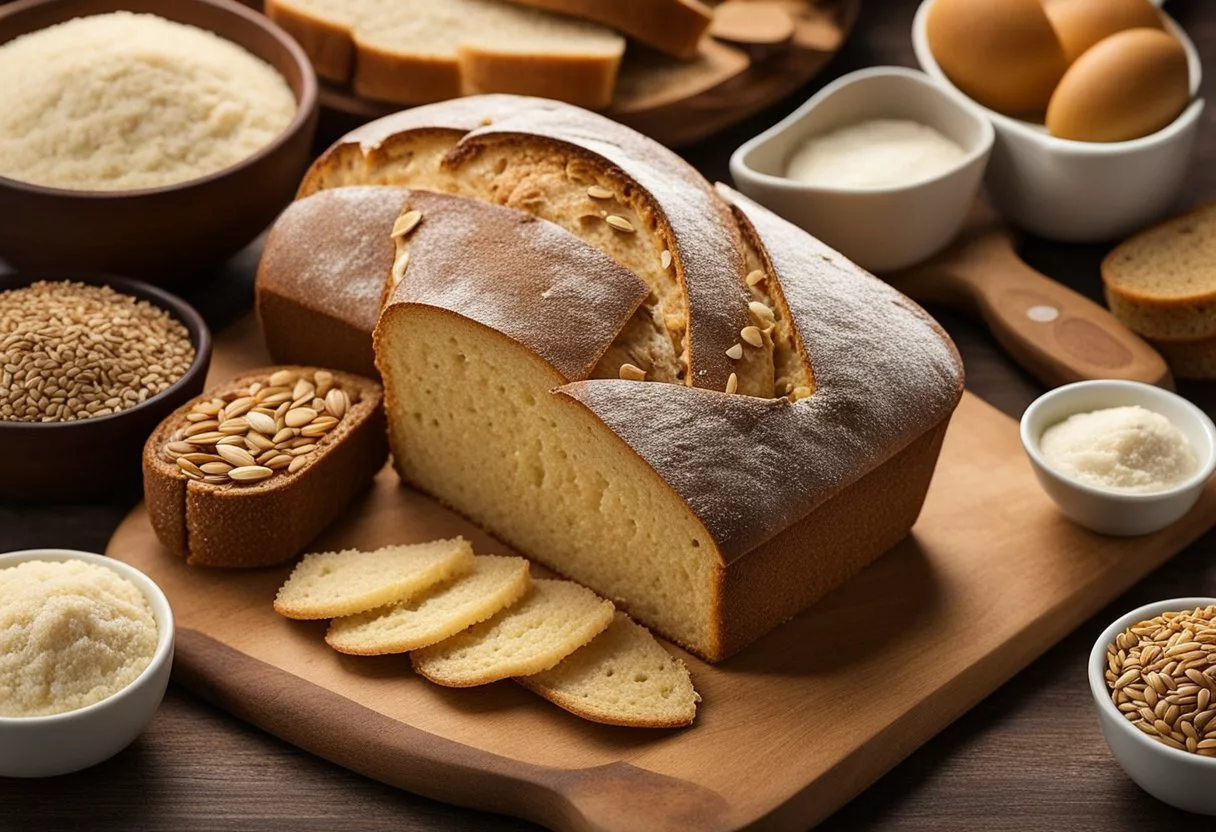
When adhering to a keto or low-carb diet, one needn’t give up the convenience and versatility of bread. Numerous alternatives offer the textural benefits without the high carbohydrate content.
Lettuce and Green Wraps
Lettuce wraps serve as a light, crunchy alternative to traditional bread. They are perfect for encasing a variety of fillings, from deli meats to tuna salad. The type of lettuce chosen can affect the wrap’s durability and taste. For instance:
- Iceberg lettuce: Offers a sturdy cup-like shape and crisp texture.
- Butter lettuce: Provides a softer, pliable leaf that’s ideal for wrapping.
Vegetable Buns and Bases
One can replace bread with thick slices of vegetables for a nutrient-dense base or bun. Notable options include:
- Portobello mushrooms: These robust, earthy-flavored caps can be grilled and used as a bun for burgers or sandwiches.
- Cauliflower: Processed and baked cauliflower can mimic the texture of traditional bread and works well for a variety of applications.
Cheese-Based Options
Cheese can be utilized to create keto-friendly bread alternatives. Its versatility can be seen in dishes like:
- Cheese wraps: Sheets of mozzarella cheese can be lightly baked until pliable, then cooled and used as a wrap.
- Baked cheese “bread”: A mixture of grated cheese with egg and seasoning, baked until golden, can serve as a flavorful substitute for many bread-based needs.
Store-Bought Keto Bread Options
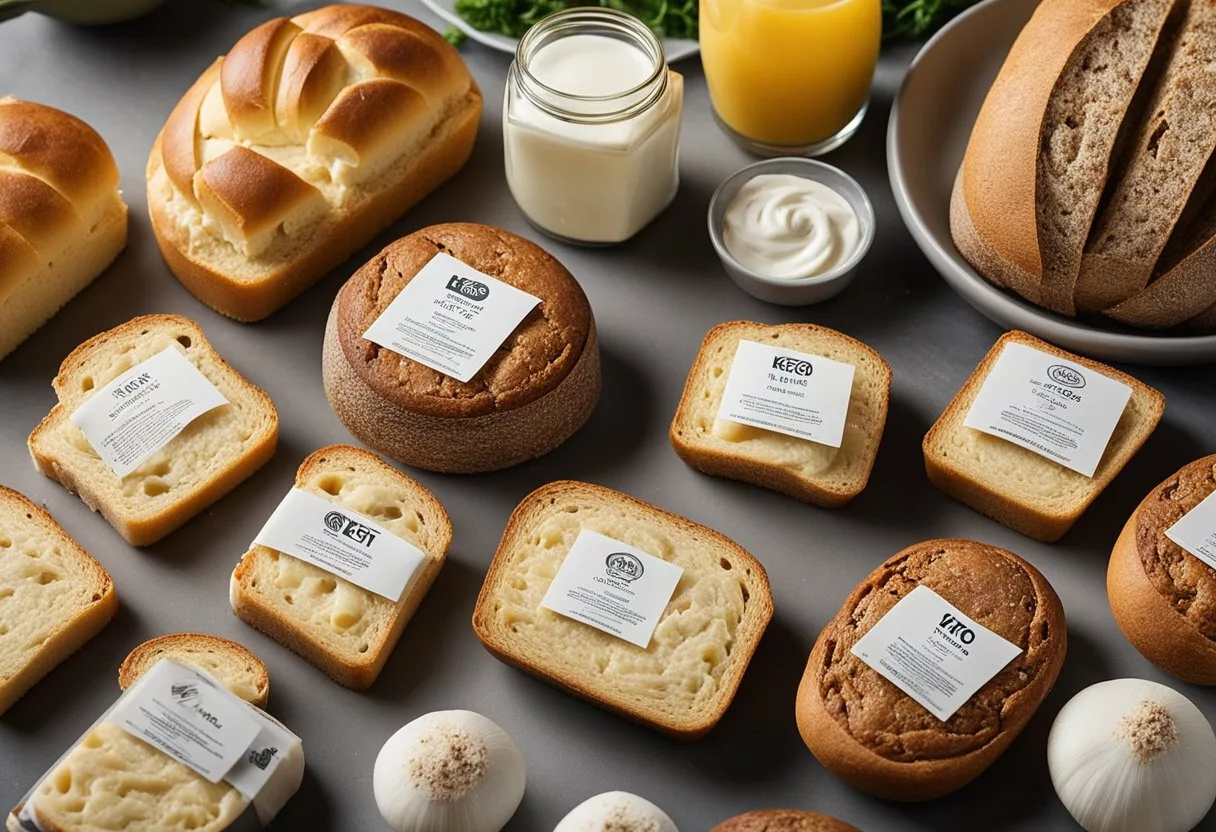
Finding a suitable keto bread alternative no longer requires long hours in the kitchen, thanks to the increased availability of commercial keto bread brands that cater to low-carb dietary preferences. Consumers should scrutinize nutritional labels and ingredients to ensure these products align with their specific dietary needs.
Commercial Keto Bread Brands
Some popular brands that offer keto-friendly bread products include:
- ThinSlim Foods: They are known for their 0 net carb bread varieties and provide a protein-rich option.
- Sola: Sola bread is crafted to be low in carbs, and the brand often emphasizes that their breads are flavorful without added sugar.
- Great Low Carb Bread Co: This brand offers a variety of bread options that are not only keto-friendly but also cater to those requiring nut-free and non-GMO alternatives.
- Carbonaut: With a focus on seeded bread options, Carbonaut is a top choice for those seeking fiber-rich bread while adhering to a keto diet.
Nutritional Labels and Ingredients to Watch For
When selecting a keto bread option from store shelves, it is critical to understand and evaluate the following aspects:
- Carbohydrates: Look for net carbs per serving, which should be low to comply with keto guidelines.
- Fiber: A high-fiber content is beneficial for digestive health and can contribute to the feeling of fullness.
- Protein: Protein-rich bread can help with muscle maintenance and satiety.
- Sweeteners: Bread with no added sugar is preferable. Watch for artificial sweeteners that may not align with your dietary choices.
- Preservatives: Some may wish to avoid preservatives, often listed on labels, to opt for a more natural product.
- Allergens: Be mindful of potential allergens, such as nuts or dairy, if you have specific sensitivities or allergies.
- Certifications: Certifications such as kosher may also be relevant to some consumers.
By paying close attention to these details, individuals following a keto diet can make informed decisions about store-bought keto bread alternatives that fit their lifestyle and nutritional requirements.
Creating Keto Bread at Home

With the rising popularity of ketogenic diets, many are seeking ways to enjoy bread without the high carbohydrate content. This section provides a guide on recipes and techniques for homemade keto bread as well as customization tips to cater to personal taste preferences and nutritional requirements.
Recipes and Techniques
For those embarking on keto baking, the key lies in selecting low-carb flours and binders. Almond flour and coconut flour serve as the foundational elements for most recipes, providing a high-fiber, high-protein, and healthy-fat base. Replacing traditional sugar with sugar alcohols like erythritol helps maintain sweetness without the carbohydrate spike.
- Ingredients:
- 2 cups almond flour
- 5 large eggs
- 1/4 cup melted coconut oil or olive oil
- 1 tbsp apple cider vinegar
- 1 tsp baking soda
- 1/2 tsp salt
Preparation:
- Preheat the oven to 350°F (175°C).
- Mix the dry ingredients to ensure even distribution of the baking soda and salt.
- In a separate bowl, beat the eggs and combine with the oil and vinegar.
- Fold the wet ingredients into the dry mixture until a consistent batter is formed.
- Pour into a loaf pan and bake for 30-40 minutes.
Customization Tips for Taste and Nutrition
Individuals can tailor keto bread to their nutritional needs and taste preferences through the addition of various ingredients. For enhanced taste, incorporating herbs such as rosemary or olives can add a touch of Mediterranean flavor. For added nutrition, one might include seeds like flax or chia, which contribute additional fiber and omega-3 fats.
To adjust texture and taste:
- For a moister bread: Add an extra egg or increase oil slightly.
- For a firmer crust: Brush the top with olive oil before baking.
- For added flavor: Incorporate seasonings like garlic powder, or top with thin slices of tomato or eggplant before baking.
By utilizing these recipes and customization strategies, individuals can enjoy bread that not only complies with their ketogenic diet but also satisfies their taste buds and nutritional aims.
Conclusion
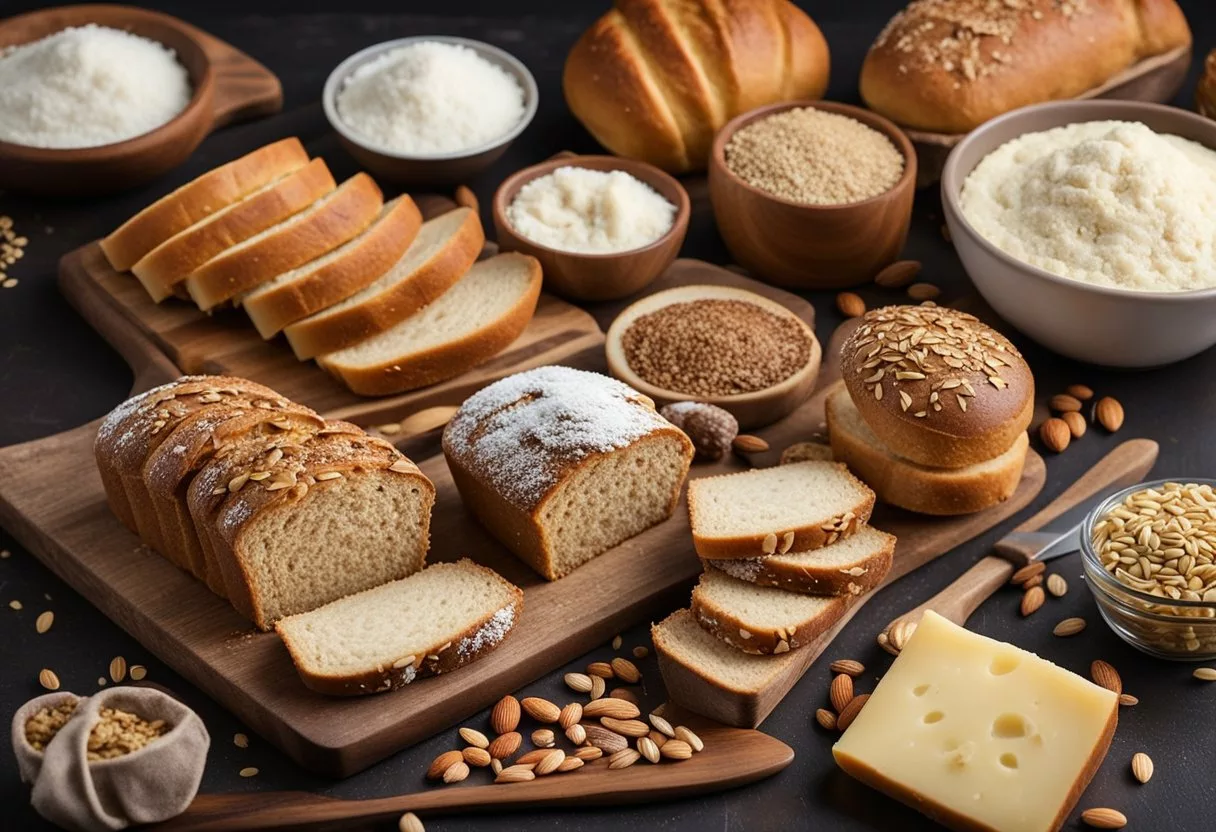
When adopting a keto or low-carb lifestyle, individuals often find that traditional bread does not align with their dietary goals. As a result, a plethora of bread alternatives have emerged, designed to satisfy bread cravings while adhering to stringent carb restrictions. One such staple substitute is almond flour bread, favored for its high fiber and healthy fat content.
Cloud bread and protein sparing bread represent additional options, the former offering a light consistency, and the latter a high-protein, low-calorie profile. For those seeking variety, nut and seed-based loaves can provide a more conventional bread-like texture. It’s important to note that each alternative varies not just in taste but also in nutritional composition, thus affecting the overall consistency and user’s adaptation.
The journey to finding the perfect keto bread substitute is personal and may require some experimentation. Those embarking on this path should pay attention to ingredients and nutritional values to ensure the replacements fit well within their dietary patterns.
Here is a simple guide for selecting a keto bread alternative:
- Almond Flour Bread: Best for a filling experience with a traditional texture.
- Cloud Bread: Ideal for those preferring a lighter option.
- Protein Sparing Bread: Suitable for individuals focusing on protein intake.
Keto bread alternatives are not only a practical adaptation for a low-carb lifestyle but can also be a delightful exploration of new flavors and textures in one’s diet.
Frequently Asked Questions
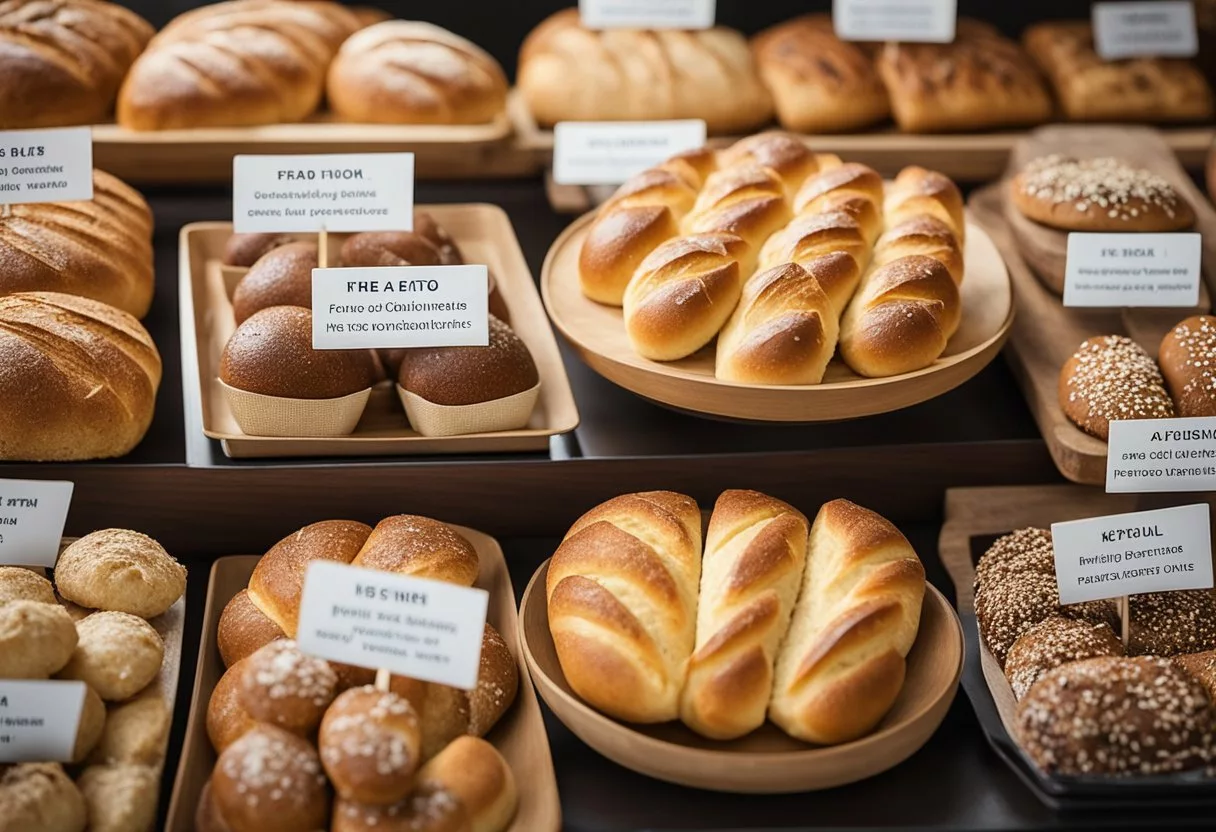
When adopting a ketogenic diet, replacing high-carb bread with appropriate alternatives is crucial for maintaining the diet’s strict macronutrient ratios. This section addresses common inquiries regarding keto-friendly bread replacements and provides practical advice for those seeking to manage their carb intake.
What are some healthy low-carb options to replace traditional bread in a keto diet?
Keto dieters have several low-carb bread alternatives available, such as Ezekiel bread, cloud bread, and eggplant disks. These options are favored due to their minimal impact on the overall carbohydrate limits of a ketogenic diet.
Can you suggest a keto-friendly bread recipe for those trying to reduce their carbohydrate intake?
A popular keto bread recipe involves using almond flour, a rich source of fiber and healthy fats. Basic ingredients include almond flour, melted coconut oil, eggs, and a bit of apple cider vinegar to create a bread-like consistency with significantly fewer carbs.
What are appropriate bread substitutes for a ketogenic breakfast?
For a ketogenic breakfast, options like almond flour pancakes or flaxseed wraps can serve as replacements for traditional bread. These substitutes keep breakfast low in net carbs while still offering a satisfying start to the day.
Which commercial low carb breads are recommended and where might one purchase them?
Commercial low-carb breads such as Sola Bread and other keto-specific brands offer convenience with only 1-2 grams of net carbs per slice. These products are often available for purchase online or at health food stores catering to low-carb dietary needs.
In terms of net carbs, is sourdough bread considered a viable option for keto dieters?
Sourdough bread typically contains a higher carb content that exceeds keto dietary restrictions; therefore, it is generally not considered a viable option for those strictly following a ketogenic diet.
What are some weight-loss friendly bread alternatives that align with keto dietary guidelines?
Weight-loss friendly bread alternatives that comply with keto dietary guidelines include coconut flour bread, cheese-based “fathead” dough, and cauliflower thins. These alternatives are lower in net carbs while still providing the texture and taste needed to replace traditional bread.
